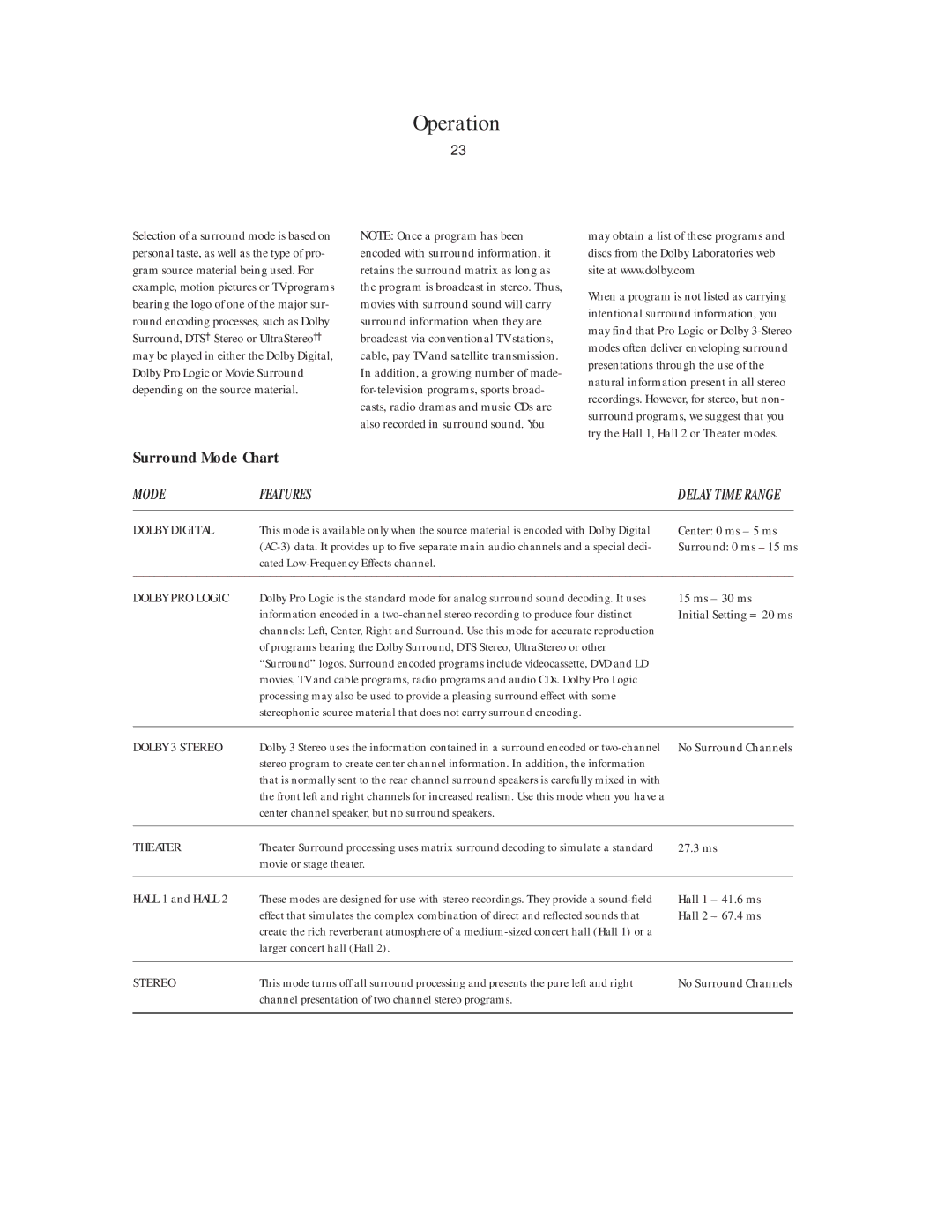
Operation
23
Selection of a surround mode is based on personal taste, as well as the type of pro- gram source material being used. For example, motion pictures or TV programs bearing the logo of one of the major sur- round encoding processes, such as Dolby Surround, DTS† Stereo or UltraStereo†† may be played in either the Dolby Digital, Dolby Pro Logic or Movie Surround depending on the source material.
NOTE: Once a program has been encoded with surround information, it retains the surround matrix as long as the program is broadcast in stereo. Thus, movies with surround sound will carry surround information when they are broadcast via conventional TV stations, cable, pay TV and satellite transmission. In addition, a growing number of made-
may obtain a list of these programs and discs from the Dolby Laboratories web site at www.dolby.com
When a program is not listed as carrying intentional surround information, you may find that Pro Logic or Dolby
Surround Mode Chart
MODE | FEATURES | DELAY TIME RANGE | ||
|
|
|
|
|
DOLBY DIGITAL | This mode is available only when the source material is encoded with Dolby Digital | Center: 0 ms – 5 ms | ||
| Surround: 0 ms – 15 ms | |||
| cated |
|
|
|
|
|
|
|
|
DOLBY PRO LOGIC | Dolby Pro Logic is the standard mode for analog surround sound decoding. It uses | 15 ms – 30 ms | ||
| information encoded in a | Initial Setting = 20 ms | ||
| channels: Left, Center, Right and Surround. Use this mode for accurate reproduction |
|
|
|
| of programs bearing the Dolby Surround, DTS Stereo, UltraStereo or other |
|
|
|
| “Surround” logos. Surround encoded programs include videocassette, DVD and LD |
|
|
|
| movies, TV and cable programs, radio programs and audio CDs. Dolby Pro Logic |
|
|
|
| processing may also be used to provide a pleasing surround effect with some |
|
|
|
| stereophonic source material that does not carry surround encoding. |
|
|
|
|
|
|
|
|
DOLBY 3 STEREO | Dolby 3 Stereo uses the information contained in a surround encoded or | No Surround Channels | ||
| stereo program to create center channel information. In addition, the information |
|
|
|
| that is normally sent to the rear channel surround speakers is carefully mixed in with |
|
|
|
| the front left and right channels for increased realism. Use this mode when you have a |
|
|
|
| center channel speaker, but no surround speakers. |
|
|
|
|
|
|
|
|
THEATER | Theater Surround processing uses matrix surround decoding to simulate a standard | 27.3 ms | ||
| movie or stage theater. |
|
|
|
|
|
|
| |
HALL 1 and HALL 2 | These modes are designed for use with stereo recordings. They provide a | Hall 1 – 41.6 ms | ||
| effect that simulates the complex combination of direct and reflected sounds that | Hall 2 – 67.4 ms | ||
| create the rich reverberant atmosphere of a |
|
|
|
| larger concert hall (Hall 2). |
|
|
|
|
|
|
| |
STEREO | This mode turns off all surround processing and presents the pure left and right | No Surround Channels | ||
| channel presentation of two channel stereo programs. |
|
|
|
|
|
|
|
|
